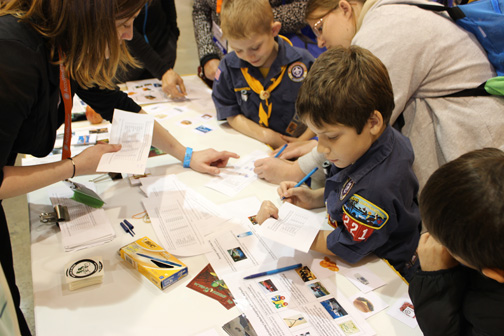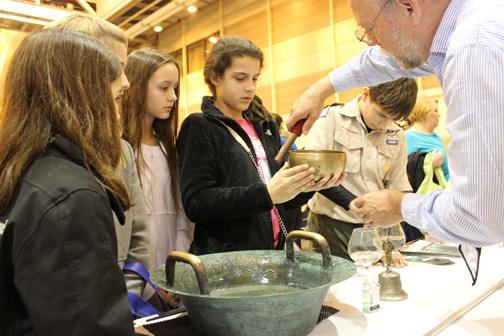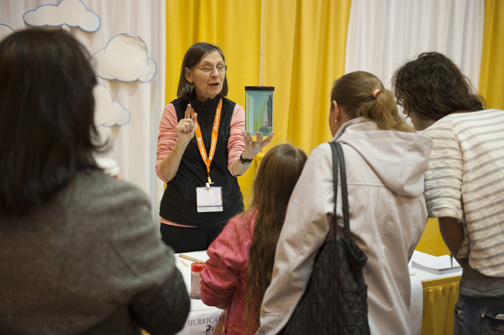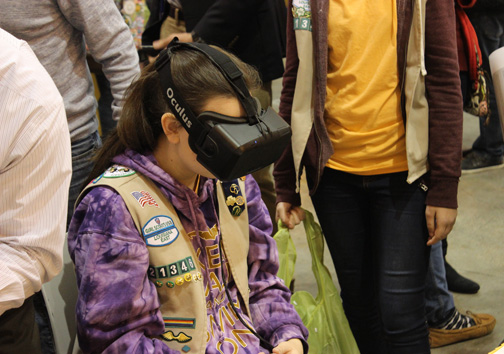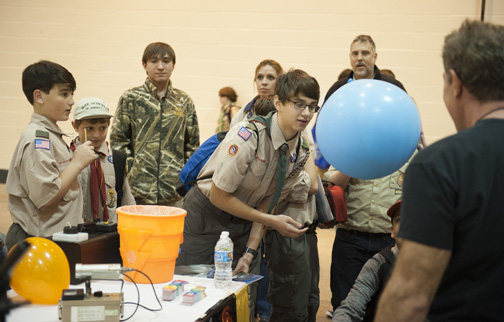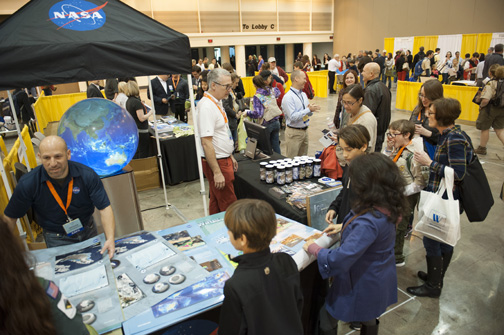New Orleans knows how to draw a crowd. The 96th AMS Annual Meeting brought together more than 5,000 members of the weather, water, and climate community for a week of activity in the Ernest N. Morial Convention Center.
Total attendance came in at a record-breaking 3,780, with the student conference drawing approximately 800 attendees. In the Exhibit Hall, there were 96 booths with close to 690 staff members manning them. Weatherfest brought in hundreds more from the New Orleans area on Sunday.
With so many members of the community in one location, there were innumerable opportunities to network, learn, and connect with friends and colleagues. Thanks to all who took part to make #AMS2016 such a success, and see you next year in Seattle!
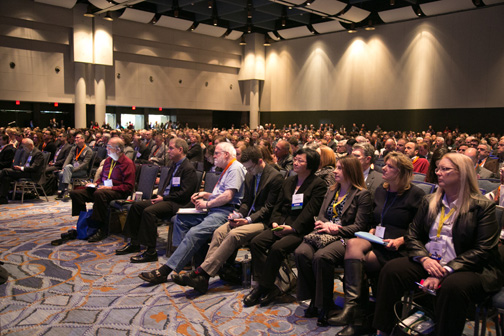
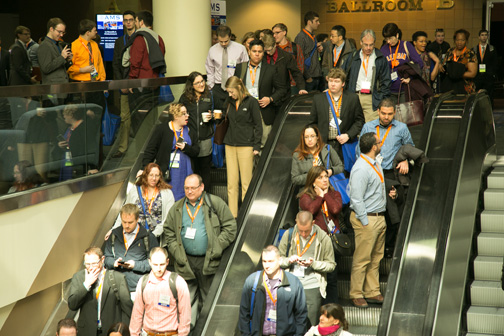
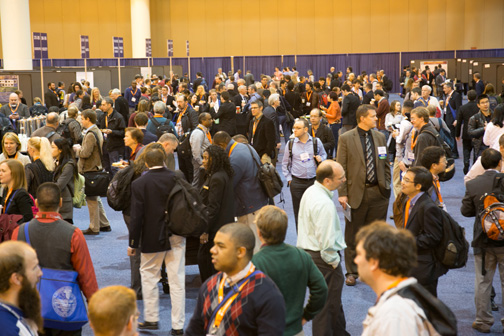

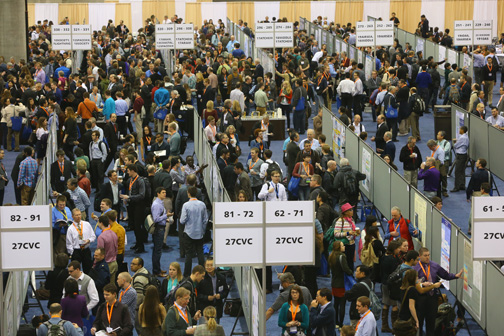

ams2016
Be Diverse and Follow Opportunity
by Kyle Brown, Valparaiso University, AMS Communications Intern
You’re no longer likely to be “just” a forecaster, broadcaster, or researcher over the course of your career in this field. That mobility—or, as some might say, instability—of working in the water, weather, and climate field was a key point from Wednesday’s AMS Presidential Town Hall meeting.
The Town Hall provided insight into career opportunities and career changes within atmospheric sciences. Panelists included Heidi Centola, manager of business development at Schneider Electric; Michael Farrar, director of the Meteorological Development Lab of the NWS; and Kevin Petty, chief science officer at Vaisala.
They stressed that some career shifts result from opportunities that present themselves through the most unlikely of sources. Other shifts come from within–the panelists recommended that midcareer professionals perform a “gut-check” to ensure that they are happy and being challenged at their jobs.
With this in mind, the panelists considered the question, “What are the trends and opportunities ahead in meteorology?” Petty suggested individuals should pursue skills in data analytics. Farrar commented on the time constraints NWS forecasters face with the multitude of incoming weather data. Forecasters now have to efficiently digest data and add value in a short amount of time. This can be achieved through strong communication skills.
Centola reminded the audience that all industries are impacted by the weather. Therefore, she recommended finding a niche for the use of one’s meteorological skills, such as in insurance or transportation. Specialization is a process that may happen in the least likely of times or ways. In fact, the panelists attested that they have been surprised with their career paths. None of them had been able to anticipate that they would be doing what they are doing today.
As a result, the unpredictable migration of careers makes it essential to broaden one’s interests and skillsets, even while developing specializations. Professionals need to keep their doors open to whatever opportunities may be knocking. Centola told the audience that she started out selling flood insurance after college and then became a salesperson for WSI. Now she finds herself in the energy sector. Petty added that students should know other disciplines, and students were advised to broaden their coursework. Farrar said he would like to see more partnerships and linkages between atmospheric scientists and others within various industries, which could also help broaden exposure.
There's a (Weather) App for That
By Alex Adams, Western Illinois University, AMS Communications Intern
If you go to any app store and search for weather apps, you will have thousands and thousands of suggestions thrown at you, ranging from home screen weather widgets; to big, multifunctional weather apps; to small independent apps, and everything in between. For about 99.99% of consumers, this selection meets all of their needs. For some weather enthusiasts and professionals, however, there is still a lot left to be desired in the mobile market. Information such as model data, forecast discussions, or even multiple radar products can only be found in a handful of apps; for some types of information, there isn’t even one app that can provide what we want. So when high-quality apps come along in the market that do satisfy our desires, it’s an event to celebrate.
During this week’s Annual Meeting, I had a chance to sit in on a session discussing new or already popular weather apps tailored specifically to meteorologists. All three of the apps that were presented impressed me greatly with their in-depth functionality and beautiful design. I was so impressed that I decided to take a moment and write down my thoughts about them.
- Seasonality Pro–Unveiled at last year’s meeting in Phoenix, Seasonality Pro is an iOS app designed to present the user with detailed model data that can be accessed and manipulated in many fashions with nothing more than a swipe of the finger. It includes several models, such as the GFS, NAM, RAP, and more. The intuitive design of the app lets you easily control what you see on screen, and it features a variety of functions that allows you to manipulate how data is displayed. As far as I am aware, this is one of the only apps out there that includes such detailed model data, and from what I saw at this presentation, I would consider it to be an incredibly well-designed app.
- Weather Informant – Another important aspect of having weather information ready at our fingertips is getting specific alerts, watches, discussions, etc., when we need them. Weather Informant is a relatively new app on iOS and Android that compiles all NWS products in a succinct, organized manner for easy access. The app includes the last 72 hours of everything the NWS has pushed out, so previous versions of discussions are available for comparison. The app also allows you to “favorite” certain NWS offices, types of products, types of warnings, or even just a keyword that might be mentioned. “Favoriting” allows you to quickly access these products from a separate page in the app, as well as enable push notifications so you can be notified if an alert goes live or is canceled. I am sure many will be excited about having all of this information accessible from a single place on our phones, and it seems like many areas of the field can greatly benefit from the convenience created by it.
- RadarScope – I don’t think I need to go into too much detail about this one. One of the most popular weather apps for meteorologists on both iOS and Android, Radarscope provides users with one of the most–if not the most–detailed sets of radar data available on mobile devices—an absolute necessity for storm chasers and weather enthusiasts. This year’s session outlined a lot of major plans for future updates for the app, as well as where it has gone in the past year. We were told that it is available on all mobile devices running iOS and Android, including the newest platforms, Apple Watch and Android Wear, and also that there are plans for a major 3.0 version update, including updates of UI design and layout for all platforms. As an Android lover, I was excited to hear about a Material Design update in the works. Additionally, a major feature that was announced was the added functionality for dual-pane display, allowing multiple products on the screen at the same time. At the mention of this feature, the entire room produced an audible gasp in amazement! This, along with the multitude of existing features, makes RadarScope one of the best weather apps out there. If you don’t have it yet, I would highly recommend purchasing it. Its developers are committed to producing the best mobile experience possible, and they were recognized for their efforts with an AMS Special Award at yesterday’s Banquet.
Visiting these sessions at the Annual Meeting and hearing presentations on these apps was a real pleasure. While the app-development community is usually pretty open, you don’t often get to see developers in person discussing their projects and sharing new ideas—it allows us to see how much love they have for their products. So if you get the chance, get on the App Store or Play Store, and check out these three awesome apps.
Read All About It! ASLI Honors Year's Best Books
For 11 years, Atmospheric Science Librarians International (ASLI) has been selecting the best books in the atmospheric sciences based on nine criteria: uniqueness, comprehensiveness, usefulness, quality, authoritativeness, organization, illustrations/diagrams, competition, and references. At their awards ceremony this afternoon at the Annual Meeting, ASLI announced their winners for 2015, giving us a new selection of titles to put on our must-read list.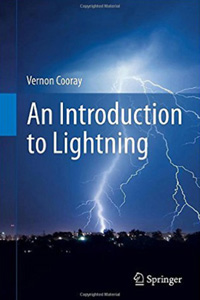
The ASLI Choice winner in the main category was An Introduction to Lightning, by Vernon Cooray, published by Springer, which ASLI recognized for being “a clearly written book that provides its readers with a thorough and accessible understanding of lightning.” In the history category, the winning title was Weatherland: Writers & Artists under English Skies, by Alexandra Harris, published by Thames & Hudson, which ASLI called “a highly original, inviting book that brings readers to the weathers of England through art and word.” And in the popular category, the winning book was Thunder & Lightning: Weather Past, Present, Future, by Lauren Redniss, published by Random House, which ASLI recognized for “designing rich, original art to accompany vivid description that creates a one-of-a-kind treatise on weather.” 
In the main category, Honorable Mention went to Climate Change and Public Health, by Barry S. Levy, published by Oxford University Press, for “bringing scientific, medical, and public policy aspects together in a useful treatment of this important topic.”
In the history category, Honorable Mention was awarded to an AMS Books title, A Scientific Peak: How Boulder Became a World Center for Space and Atmospheric Science, by Joseph P. Bassi, praised by ASLI for being “a well-researched and written description of this western city’s road to atmospheric science fame.” You can purchase A Scientific Peak this week at the AMS Resource Center in the Exhibit Hall!
Honorable Mentions in history also went to Sea of Storms: A History of Hurricanes in the Greater Caribbean from Columbus to Katrina, by Stuart B. Schwartz, published by Princeton University Press, for “enabling readers to discover 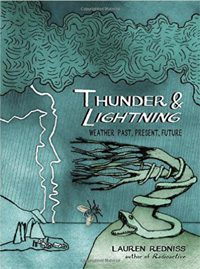 more about this part of the world through its tempests”; and The Weather Experiment: The Pioneers Who Sought to See the Future, by Peter Moore, published by Farrar, Straus and Giroux, which was recognized for “a vivid account of those early scientists and the weather they sought to understand.”
more about this part of the world through its tempests”; and The Weather Experiment: The Pioneers Who Sought to See the Future, by Peter Moore, published by Farrar, Straus and Giroux, which was recognized for “a vivid account of those early scientists and the weather they sought to understand.”
In the popular category, Honorable Mention was awarded to Rain: A Natural and Cultural History, by Cynthia Barnett, published by Crown Publishers, honored for being a book “that celebrates rain in all its history, forms and life”; and Melting Away: Images of the Arctic and Antarctic, by Camille Seaman, published by Princeton Architectural Press, for “the author-photographer’s composition, creativity, and artistry that depict the beauty of and pressures upon both our polar realms.”
Visit the ASLI Choice Awards website to view past winners and to learn how to nominate a book next year.
25 Years of Educating and Energizing
In education, 1984 was a watershed year: Malcolm Walker of the U.K Royal Meteorological Society convened the first international conference in school and popular meteorological education. A small group of Americans headed to Oxford, curious to see how the rest of the world was starting to experiment with ways of improving teaching.
As David Smith tells it, Walker hooked attendees into a passion for meteorological education. The effects are now felt in the AMS and through the nation. For example, Eugene Bierly, an attendee at the Oxford meeting, offered money from NSF to help start up an initiative by Ira Geer—another attendee—which became the AMS Education Program in Washington, D.C.
For his own part, Smith, now retired from the U.S. Naval Academy, went on to co-chair 22 years of AMS Education Symposia (http://bit.ly/1ngkjJm)—the first being in 1992, at the AMS Annual Meeting in Atlanta. This year he’s been here in New Orleans, helping to celebrate the symposium’s 25 years of bringing teachers and scientists together on their common mission of spreading knowledge.
“I don’t think we would be here today without the energy and the vision Malcolm brought to these conferences,” Smith told the symposium audience before the celebratory cake cutting.
The group of 21 master teachers in Geer’s network have brought a new energy to the AMS meeting, with their hands-on, interactive presentations. “They absolutely turned the society on their heads,” Smith said. They also drew others in AMS into a renewed commitment to great and creative teaching that thrives each year through the recurring AMS symposium.
“When I think about education, I think about exciting that spark: Giving young people a new way to see the world,” said Raj Pandya of AGU, another former co-chair who now heads the AMS Commission on Human Resources, said at Monday’s celebratory session.
“Education is a really important part of what we do,” outgoing AMS President Sandy MacDonald said in his remarks opening the symposium. “In some ways it is the most important part of what we do.”
Smith and Pandya added some more thoughts on the value of the Education Symposium in a video interview yesterday:
WOW: Half-A-Billion Citizen Observations and Counting
Non-traditional observations of weather conditions from smartphones, driverless vehicles, and other sensor-based platforms are exploding as technology improves and becomes cheaper. But the traditional infrastructure in place to gather observations can’t keep up with the mass influx of new data. WOW. That’s the Met Office in the United Kingdom’s solution to the problem. Its Weather Observations Website is not only up and running. It’s humming.
Since it was launched in 2011, WOW (http://wow.metoffice.gov.uk/) has seen more than 700 million observations submitted by more than 10,000 citizen scientists worldwide. WOW focuses on ingesting data from personal weather stations, Simon Gilbert, head of the Met Office observations partnerships, said in his presentation Monday morning at the 96th AMS Annual Meeting in New Orleans. This huge volume of data includes the entire 200-year climate record from Oxford University.
The success of WOW has encouraged the Bureau of Meteorology in Australia, MetService in New Zealand, and KNMI in the Netherlands to implement their own portals into the website. Collectively, they have reported great success in extending their reach, primarily through “really effective partnerships” connecting the public with the private sector, Gilbert says.
A new version of WOW, the WOW Engine, is currently being developed as a more flexible and adaptable data management platform. Using application software to talk to hardware, it will be possible to quickly and easily ingest new sources of observational data, including complex metadata, which will be managed, stored, and visualized through a variety of channels. The metadata will comply with the WMO Integrated Global Observing System (WIGOS) Metadata principles, allowing users to benefit from the potential for WIGOS to create a ‘”network of networks.”
Gilbert reports the use of WOW, which is supported by the UK Department for Education and the Royal Meteorological Society, is expanding in schools as well. Weather stations are being provided to schools, and teachers and students are being encouraged to submit data.
As traditional threshold-based weather warnings transition toward impact based warnings, the need to gather evidence of impacts will be critical. WOW contains this capability and soon will be available for mining data from social media and other live sources.
Harnessing the power of citizen scientists is potentially a game changer for meteorology as the increasing resolution of NWP models is not matched by a corresponding increase in the density of traditional observing networks. The citizen scientist with an app on their phone, or in their car or home, can provide supplementary observations that will provide useful additional detail to modelers and forecasters.
A key challenge is how to manage the balance between quantity and quality of the observations and to identify the most effective ways to use this kind of data, Gilbert says. He personally doesn’t think such crowdsourcing will replace funded observation networks. But even with WOW’s low-level quality control capability, the shear volume of data can be used to identify trends.
Inspired by Others but Measured Only Against Yourself
Following Jonathan Martin’s address, Eric Snodgrass of the University of Illinois spoke to the AMS Student Conference this weekend about how to get the most out of an Annual Meeting. Here’s a condensed version of an inspiring story he shared:
It’s the way that you spend your time for the next two days both in sessions and in talks and out of session, in the hallways, at lunch, at dinner, and on Bourbon Street, that is going to make this conference memorable for you. I think conferences like this are about three things: The first thing is exposure. You were just exposed to some serious meteorology from Dr. Martin.
You’re going to see stuff like that over the next few days from the top minds on the planet. When you see it, the second thing is, you need to be inspired. Look at what people are doing, take it away. Go back and apply it to your research. Take it and run with it.
I want to talk about a guy named Cliff Young. He’s Australian, a sheepherder. Two thousand sheep on a two-thousand acre farm. Forty years of herding sheep on foot puts you in pretty darn good shape.
So its not a big surprise that Cliff Young decided to run an ultramarathon from Sydney, Australia, to Melbourne—544 miles. The problem is, Cliff Young was 61 years old; he signs up the day of the event and he showed up in overalls, a t-shirt, a baseball cap, and rubber boots—not the attire of an ultramarathoner. He was also three times the age of most of the competitors. Cliff gets to the very back of the line. When the race starts he lets the others go first. There’s another big problem: Cliff can’t run. He shuffles; his stride is only like two feet long.
Now there’s a strategy to the ultramarathon. Run 18 hours and sleep 6. Then run another 18 hours and sleep six. You do that until you finish the race. Cliff had no training, however. That night as everyone else slept Cliff continued to shuffle. He shuffled right past every single one of those racers. For five days and 50 minutes, he shuffled his way to Sydney. He broke the record for the race by two days. He beat second place by 10 hours. When he crossed the finish line he did not know he was going to receive $10,000 in cash. That was a lot of money in 1983. He didn’t know what to do with it, so he waited and handed out a thousand dollars to each of the next competitors who crossed the line.
It’s easy to find inspiration in that—it’s the ultimate tortoise and hare story. So why am I telling you this in an AMS conference? I’ll be honest: the first few times I came to a conference like this I was incredibly intimidated by what I saw. You will see some amazing things by students, faculty, and research scientists. So inevitably sometimes you get in a comparison mode: “How do I compare to what they’re doing?”
I’m going to tell you something, however. You are allowed to compare yourself to only one person . . . and that one person is you. You see what you don’t know about Cliff was that the year before this race, he’d tried to run another ultramarathon. That was a thousand miles long, but he only made it 500 miles before he collapsed.
This race was 544 miles. All he wanted to do was be better than he was a year ago. The five points that Dr. Martin gave to you–that doesn’t happen in a few days. It takes time; it takes perseverance. And you must remember that the only person you can compare yourself to is who you were yesterday, a month ago, a year ago. If you’re making progress, everything is going fine.
Students of Leadership
Jonathan Martin of the University of Wisconsin, recipient of the 2015 AMS Edward N. Lorenz Teaching Excellence Award, spoke to the attendees of the Student Conference this weekend. Here’s a condensed version of his remarks:
It’s a great pleasure to meet with you all. I’ve decided to say a few words about leadership because that’s what you all are preparing yourselves to do as you get educated.
I want you to take a second and look around where you’re sitting. You’re looking at the next generation of leaders in our field, in our country, and in our world. You all have a couple of days and maybe a week to get to know those new leaders, and I encourage you to take advantage of that circumstance while you are here.
But also, in the background, make sure you take some time to consider what it is that you are getting yourselves into. Because you will be the ones society turns to for solutions to its problems and for encouragement and optimism in difficult times.
Though effective leadership arises from the interaction of many personal habits and characteristics of thought and action, I’ll suggest just five of these based on my own experience:
- You have to master the fundamentals of our science as best as you can and always strive to consider those notions from new perspectives. If you master them, it puts you in a position to react effectively to new situations, new challenges. You have to adopt an intellectually athletic position: relaxed but alert, focused but free of anxiety, ready to spring, ready to execute based on your mastery of the fundamentals.
- Now, because you may be called upon to address issues of broadening concern, you also must understand the difference between assertion and reasoned argument. Opinions elevated to the level of assertions too often pass themselves off as reasoned argument. Adopt positions for yourself that are defensible, that appeal to the facts, and that are arguable.
- To contribute to complicated discussions and help formulate solutions, you must understand the distinction between simple and easy. Most of the fundamental ideas at the heart of our science are simple in their concepts, but none of them are easy. This applies to a lot of things you will encounter both inside and out of the sciences.
- Invest yourself in the work you find interesting. I’m going to follow my curiosity wherever it leads. I hope in your career you can do the same. Make sure that when the opportunity arises, you do that.
- And finally, you can’t be a part of the solution to any problem if no one understands what you’re talking about. Here are some master storytellers from very different eras and very different background periods: Homer, Mark Twain, Alex Haley. They express their ideas clearly, eloquently, and precisely, and connect to universals. You should imitate these masters. And another: Arndt Eliassen. If you want to read the best-written scientific paper I’ve ever read—and I had the great opportunity to tell him that in person—it’s his 1962 paper, “On the Vertical Circulation in Frontal Zones.” Read that and you’ll agree, this is really good storytelling. So you’re going to have to have excellent storytelling skills. Learning to communicate effectively is absolutely essential for leadership. When you go back to your campuses, tell all your young colleagues and remind yourself, “Do not neglect your humanities classes.” You’ve got to learn how to use those.
Leadership almost always involves teamwork. So you have to be able create a climate of teamwork in which although the threat of failure is recognized, the fear of failure does not exist. This permits the group to adopt the enabling perspective that you win as a team and you lose as a team. I consider the establishment of this perspective as the most critical element of team leadership because it commits every member of the team to commit fully to the success of the project without the concern that the failure of the project will be pinned on them. Such an environment encourages appropriate risk-taking, unconventional but reasonable thinking, and dedicated follow-through—indispensable ingredients for success.
The teams you lead in your career will be in part composed of the people in this room. So commit yourselves to excellence and treat each other well. That means acknowledge the contributions of others, and disagree respectfully when you have to by offering arguments and not personal attacks.
The 21st Century will be one of important transformation for our society. Successful response to the many challenges we face will depend on a cadre of flexible, powerful, inventive, and resilient minds. And you possess those minds. It’s up to you to marry them to dedicational urgency to help us solve our problems.
The AMS Annual Meeting: Much More than Science
The Annual Meeting is upon us! This year, we return to the beautiful city of New Orleans expecting yet another great meeting full of stimulating ideas, valuable information, and new products.
The Annual Meeting is well known for bringing together more than 3,000 scientists, researchers, professionals, educators, students, and others across the weather, water, and climate community. The more than 2,000 presentations and 900 posters cover an incredible array of topics and disciplines that represent the cutting edge of scientific thinking, technology, research, collaboration, and understanding. 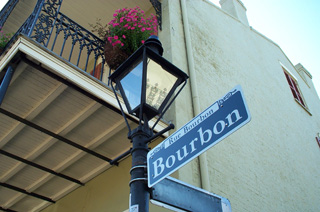
Yet you probably realize the success of the meeting goes beyond merely showcasing vital science and services. The Annual Meeting is also a great opportunity to engage in networking and career development for early-career, midcareer, and even late-career professionals. We hear every year from attendees who tell us how much networking means to them, and how much they appreciate a chance to meet with peers and colleagues, some of whom they see only this one time a year.
The weather enterprise has grown and changed immensely over the past decade, and many expect that to continue in the years to come. Today, we see areas of science coming together more intensively than ever to share, work, and collaborate. People in fields like energy, agriculture, transportation, and the social sciences work closely with physical scientists. These are important developments for those who are interested in starting–or changing–their careers.
This year’s meeting offers attendees many opportunities to listen to talks and presentations on careers in the public, private, and academic sectors across the enterprise.
Sunday’s Conference for Early Career Professionals will feature numerous helpful discussions—from advice on networking and interviewing to help with finding a mentor and mastering “soft skills.” The conference will also include a panel discussion of professionals who will share their perspectives on atmospheric sciences careers.
The AMS Board for Early Career Professionals will also host a Town Hall Meeting on Monday on “ ‘Outside the Box’ Skillsets for Staying Relevant and Landing the Next Job,” which will highlight skills that may not be required in an academic curriculum, but could be valuable in a resume.
Wednesday’s Town Hall Meeting on “Demystifying Careers in the Atmospheric Sciences” will present an overview of employment in the weather, water, and climate sciences. What skill sets are most important to employers? What employment trends and changes are occurring, and what are some areas of future growth? This meeting will explore those and other career-related questions.
For budding broadcasters, Tuesday’s Town Hall Meeting on “The Work Behind the Scenes” will provide a glimpse at some of the research broadcast meteorologists work on when they’re not in front of the camera—showing that there’s more to the job than may meet the eye.
And for students, this Saturday’s Career Fair will allow attendees of the AMS Student Conference to view available job opportunities, network with government-agency and private-industry employees, meet graduate school recruiters, and schedule interviews with school representatives and potential employers.
This is just a sampling of the career-related events taking place during the week. The Annual Meeting is a great chance to better connect to your career goals and directions. It’s also a great opportunity to meet others while networking with peers and colleagues engaged in the work of benefitting society with the science of weather, water, and climate.

